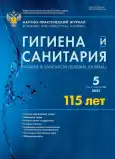Hepatotoxicity of cadmium at long-term exposure
- Authors: Khmel A.O.1, Repina E.F.1, Ryabova Y.V.1, Smolyankin D.A.1, Baigildin S.S.1, Akhmadeev A.R.1, Karimov D.O.1,2, Valova Y.V.1
-
Affiliations:
- Ufa Research Institute of Occupational Health and Human Ecology
- N.A. Semashko National Research Institute of Public Health
- Issue: Vol 104, No 5 (2025)
- Pages: 631-635
- Section: PREVENTIVE TOXICOLOGY AND HYGIENIC STANDARTIZATION
- Published: 15.12.2025
- URL: https://rjsvd.com/0016-9900/article/view/689405
- DOI: https://doi.org/10.47470/0016-9900-2025-104-5-631-635
- EDN: https://elibrary.ru/cdiped
- ID: 689405
Cite item
Abstract
Keywords
About the authors
Alexandra O. Khmel
Ufa Research Institute of Occupational Health and Human Ecology
Email: sallararaff@gmail.com
Elvira F. Repina
Ufa Research Institute of Occupational Health and Human Ecology
Email: e.f.repina@bk.ru
Yulia V. Ryabova
Ufa Research Institute of Occupational Health and Human Ecology
Email: ryabovaiuvl@gmail.com
Denis A. Smolyankin
Ufa Research Institute of Occupational Health and Human Ecology
Email: smolyankin.denis@yandex.ru
Samat S. Baigildin
Ufa Research Institute of Occupational Health and Human Ecology
Email: baigildin.samat@yandex.ru
Aidar R. Akhmadeev
Ufa Research Institute of Occupational Health and Human Ecology
Email: dgaar87@gmail.com
Denis O. Karimov
Ufa Research Institute of Occupational Health and Human Ecology; N.A. Semashko National Research Institute of Public Health
Email: karimovdo@gmail.com
Yana V. Valova
Ufa Research Institute of Occupational Health and Human Ecology
Email: q.juk@ya.ru
References
- Саломеина Н.В., Машак С.В., Дьякон В.В., Колмакова О.А., Охотина А.А. Морфологические изменения печени беременных крыс при введении различных доз кадмия. Медицина и образование в Сибири. 2015; (3): 92–6. https://elibrary.ru/vxokzv
- Жаксылыкова А.К., Алмабаев Ы.А., Ткаченко Н.Л. Структурная перестройка лимфатического узла печени при экзотоксикозе хлористым кадмием. Медицина и образование в Сибири. 2014; (2): 43–7. https://elibrary.ru/sgrwid
- Кадникова Е.П. Химическое загрязнение среды обитания и состояние здоровья детей дошкольного возраста, по данным социально-гигиенического мониторинга. Здоровье населения и среда обитания. 2019; (2): 9–14. https://doi.org/10.35627/2219-5238/2019-311-2-9-14 https://elibrary.ru/kjlgvf
- Гулиева С.В., Гараев Г.Ш.О., Халилов В.Г.О., Раджабова Ф.О. Влияние кадмия на биохимические процессы в организме в условиях экспериментального гипотиреоза. Вестник науки и образования. 2019; (5): 67–71. https://elibrary.ru/stdcsr
- Фазлыева А.С., Усманова Э.Н., Даукаев Р.А., Каримов Д.О., Валова Я.В., Смолянкин Д.А. и др. Распределение кадмия и экспрессия металлотионеина в органах крыс при острой интоксикации. Гигиена и санитария. 2020; 99(9): 1011–5. https://doi.org/10.47470/0016-9900-2020-99-9-1011-1015 https://elibrary.ru/thctsf
- Шабардина Л.В., Сахаутдинова Р.Р. Изменения некоторых показателей печени крыс после субхронического воздействия хлорида кадмия на фоне физической нагрузки. В кн.: Актуальные вопросы современной медицинской науки и здравоохранения: Сборник статей IX Международной научно-практической конференции молодых ученых и студентов. Екатеринбург; 2024: 563–6.
- Елясин П.А., Залавина С.В., Машак А.Н., Равилова Ю.Р., Первойкин Д.М., Надеев А.П. и др. Классическая долька печени как модель исследования воздействия субтоксичных доз кадмия. Экология человека. 2018; (1): 47–52. https://doi.org/10.33396/1728-0869-2018-1-47-52 https://elibrary.ru/ykuzoe
- Марченко А.Л. Биологическое действие кадмия в организме животных и человека. Scientia Potentia Est. 2019; (2): 1–2.
- Усманова Э.Н., Фазлыева А.С., Каримов Д.О., Хуснутдинова Н.Ю., Репина Э.Ф., Даукаев Р.А. Динамика накопления кадмия в печени и почках крыс при острой интоксикации. Медицина труда и экология человека. 2019; (2): 69–74. https://elibrary.ru/efdllb
- Фазлыева А.С., Усманова Э.Н., Каримов Д.О., Смолянкин Д.А., Даукаев Р.А. Накопление кадмия в живых системах, как проблема загрязнения окружающей среды. Медицина труда и экология человека. 2018; (3): 47–51. https://elibrary.ru/mgghbr
- Ma Y., Su Q., Yue C., Zou H., Zhu J., Zhao H., et al. The effect of oxidative stress-induced autophagy by cadmium exposure in kidney, liver, and bone damage, and neurotoxicity. Int. J. Mol. Sci. 2022; 23(21): 13491. https://doi.org/10.3390/ijms232113491
- Anadozie S.O., Adewale O.B., Akawa O.B., Olayinka J.N., Osukoya O.A., Umanah M.M., et al. Protective effect of aqueous fruit extract of Mondia whitei against cadmium-induced hepatotoxicity in rats. J. Herbmed Pharmacol. 2023; 12(1): 159–67. https://doi.org/10.34172/jhp.2023.16
- Ramadan O.I., Amr I.M.I., Mahmoud M.E. Effect of selenium and olive oilon hepatotoxicity induced by cadmium chloride in adult male albino rats (structural, biochemical and immunohistochemical study). Ann. Rom. Soc. Cell Biol. 2019; 23(2): 128–41.
- Mallya R., Chatterjee P.K., Vinodini N.A., Chatterjee P., Mithra P. Moringa oleifera leaf extract: beneficial effects on cadmium induced toxicities – a review. J. Clin. Diagn. Res. 2017; 11(4): CE01–4. https://doi.org/10.7860/JCDR/2017/21796.9671
- Matović V., Buha A., Ðukić-Ćosić D., Bulat Z. Insight into the oxidative stress induced by lead and/or cadmium in blood, liver and kidneys. Food Chem. Toxicol. 2015; 78: 130–40. https://doi.org/10.1016/j.fct.2015.02.011
- Al-Nasser I.A. Cadmium hepatotoxicity and alterations of the mitochondrial function. J. Toxicol. Clin. Toxicol. 2000; 38(4): 407–13. https://doi.org/10.1081/clt-100100950
- Sun J., Chen Y., Wang T., Ali W., Ma Y., Yuan Y., et al. Cadmium promotes nonalcoholic fatty liver disease by inhibiting intercellular mitochondrial transfer. Cell Mol. Biol. Lett. 2023; 28(1): 87. https://doi.org/10.1186/s11658-023-00498-x
- Смолянкин Д.А., Тимашева Г.В., Хуснутдинова Н.Ю., Байгильдин С.С., Репина Э.Ф., Фазлыева А.С. и др. Оценка функционального состояния печени и почек лабораторных животных после воздействия кадмием в подостром эксперименте. Микроэлементы в медицине. 2021; 22(1): 72−7. https://doi.org/10.19112/2413-6174-2021-22-1-72-77 https://elibrary.ru/figznp
- Смолянкин Д.А., Валова Я.В., Каримов Д.О., Байгильдин С.С., Фазлыева А.С., Каримов Д.Д. и др. Исследование воздействия хлорида кадмия на некоторые маркерные ферменты печени экспериментальных животных. Juvenis Scientia. 2023; 9(6): 30–41. https://doi.org/10.32415/jscientia_2023_9_6_30-41 https://elibrary.ru/ycwflu
- Очилов К.Р. Структурное строение клеток ткани печени при воздействии кадмия. Новости образования: исследование в XXI веке. 2023; 7(100): 372–7.
- Feng R., Guo X., Kou Y., Xu X., Hong C., Zhang W., et al. Association of lipid profile with decompensation, liver dysfunction, and mortality in patients with liver cirrhosis. Postgrad Med. 2021; 133(6): 626–38. https://doi.org/10.1080/00325481.2021.1930560
- Chen S., Yin P., Zhao X., Xing W., Hu C., Zhou L., et al. Serum lipid profiling of patients with chronic hepatitis B, cirrhosis, and hepatocellular carcinoma by ultra fast LC/IT-TOF MS. Electrophoresis. 2013; 34(19): 2848–56. https://doi.org/10.1002/elps.201200629
- Aguilera-Méndez A., Álvarez-Delgado C., Hernández-Godinez D., Fernandez-Mejia C. Hepatic diseases related to triglyceride metabolism. Mini Rev. Med. Chem. 2013; 13(12): 1691–9. https://doi.org/10.2174/1389557511313120001
- Nderitu P., Bosco C., Garmo H., Holmberg L., Malmström H., Hammar N., et al. The association between individual metabolic syndrome components, primary liver cancer and cirrhosis: A study in the Swedish AMORIS cohort. Int. J. Cancer. 2017; 141(6): 1148–60. https://doi.org/10.1002/ijc.30818
- van der Wulp M.Y., Verkade H.J., Groen A.K. Regulation of cholesterol homeostasis. Mol. Cell Endocrinol. 2013; 368(1–2): 1–16. https://doi.org/10.1016/j.mce.2012.06.007
- Maxfield F.R., Tabas I. Role of cholesterol and lipid organization in disease. Nature. 2005; 438(7068): 612–21. https://doi.org/10.1038/nature04399
Supplementary files









